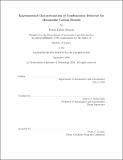| dc.contributor.advisor | Zoltán S. Spakovszky. | en_US |
| dc.contributor.author | Paxson, Derek Edwin | en_US |
| dc.contributor.other | Massachusetts Institute of Technology. Department of Aeronautics and Astronautics. | en_US |
| dc.date.accessioned | 2017-02-22T19:01:20Z | |
| dc.date.available | 2017-02-22T19:01:20Z | |
| dc.date.copyright | 2016 | en_US |
| dc.date.issued | 2016 | en_US |
| dc.identifier.uri | http://hdl.handle.net/1721.1/107053 | |
| dc.description | Thesis: S.M., Massachusetts Institute of Technology, Department of Aeronautics and Astronautics, 2016. | en_US |
| dc.description | Cataloged from PDF version of thesis. | en_US |
| dc.description | Includes bibliographical references (pages 149-152). | en_US |
| dc.description.abstract | This thesis is focused on the experimental characterization of the thermodynamic properties and behavior of carbon dioxide (CO₂ ) undergoing non-equilibrium condensation near the critical point in a convergent-divergent nozzle. The insight gained facilitates new modelling tools that guide the design of more efficient compressors for applications such as carbon capture and sequestration (CCS), enhanced oil recovery (EOR), and Supercritical CO₂ power cycles. Modelling of non-equilibrium condensation requires knowledge of the fluid's metastable (subcooled-vapor) properties and related stability limit, known as the Wilson line. While there have been computational studies on metastable CO₂, there is no experimental data in the literature to anchor these results for conditions near the critical point. A laboratory scale blowdown experiment was constructed to visualize the onset of condensation, allowing for a first-of-its-kind assessment of the Wilson line, and the accuracy of two methods for determining metastable properties: spline-based extrapolation and equation of state (EOS) based extrapolation using the Span and Wagner EOS. The experiment consists of a heated charge tank and an optically accessible instrumented convergent-divergent nozzle. The nozzle was sized such that relevant length and time-scales were similar to those of the flow around a compressor leading edge. Pressure transducers were used to provide static pressure data, and a novel shearing interferometer, tailored to the high densities of supercritical CO₂, was developed to measure the static density. The maximum errors between measured and calculated metastable densities are 2%, and 15% for the Span and Wagner EOS and tabular extrapolation methods, respectively. The conditions under which condensation was observed in the experiment were used to establish the Wilson line. Based on this, a new safety limit for compressor inlet conditions near the critical point enabling greater compressor efficiencies was developed. | en_US |
| dc.description.statementofresponsibility | by Derek Edwin Paxson. | en_US |
| dc.format.extent | 191 pages | en_US |
| dc.language.iso | eng | en_US |
| dc.publisher | Massachusetts Institute of Technology | en_US |
| dc.rights | MIT theses are protected by copyright. They may be viewed, downloaded, or printed from this source but further reproduction or distribution in any format is prohibited without written permission. | en_US |
| dc.rights.uri | http://dspace.mit.edu/handle/1721.1/7582 | en_US |
| dc.subject | Aeronautics and Astronautics. | en_US |
| dc.title | Experimental characterization of condensation behavior for metastable carbon dioxide | en_US |
| dc.type | Thesis | en_US |
| dc.description.degree | S.M. | en_US |
| dc.contributor.department | Massachusetts Institute of Technology. Department of Aeronautics and Astronautics | |
| dc.identifier.oclc | 971022352 | en_US |
